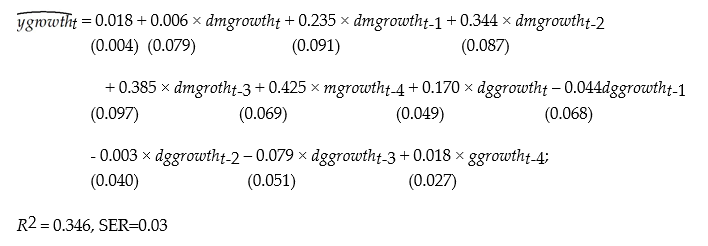A model that attracted quite a bit of interest in macroeconomics in the 1970s was the St. Louis model. The underlying idea was to calculate fiscal and monetary impact and long run cumulative dynamic multipliers, by relating output (growth)to government expenditure (growth)and money supply (growth). The assumption was that both government expenditures and the money supply were exogenous. Estimation of a St. Louis type model using quarterly data from 1960:I-1995:IV results in the following output (HAC standard errors in parenthesis): 
where ygrowth is quarterly growth of real GDP, mgrowth is quarterly growth of real money supply (M2), and ggrowth is quarterly growth of real government expenditures. "d" in front of ggrowth and mgrowth indicates a change in the variable.
(a)Assuming that money and government expenditures are exogenous, what do the coefficients represent? Calculate the h-period cumulative dynamic multipliers from these. How can you test for the statistical significance of the cumulative dynamic multipliers and the long-run cumulative dynamic multiplier?
(b)Sketch the estimated dynamic and cumulative dynamic fiscal and monetary multipliers.
(c)For these coefficients to represent dynamic multipliers, the money supply and government expenditures must be exogenous variables. Explain why this is unlikely to be the case. As a result, what importance should you attach to the above results?
Correct Answer:
Verified
View Answer
Unlock this answer now
Get Access to more Verified Answers free of charge
Q23: In time series data, it is useful
Q24: In the distributed lag model, the dynamic
Q25: Money supply is linked to the monetary
Q26: Your textbook mentions heteroskedasticity- and autocorrelation- consistent
Q27: In the distributed lag model, the coefficient
Q29: To estimate dynamic causal effects, your textbook
Q30: Consider the following distributed lag model
Q31: Given the relationship between the two variables,
Q32: Consider the distributed lag model Yt =
Q33: When Xt is strictly exogenous, the following
Unlock this Answer For Free Now!
View this answer and more for free by performing one of the following actions

Scan the QR code to install the App and get 2 free unlocks

Unlock quizzes for free by uploading documents